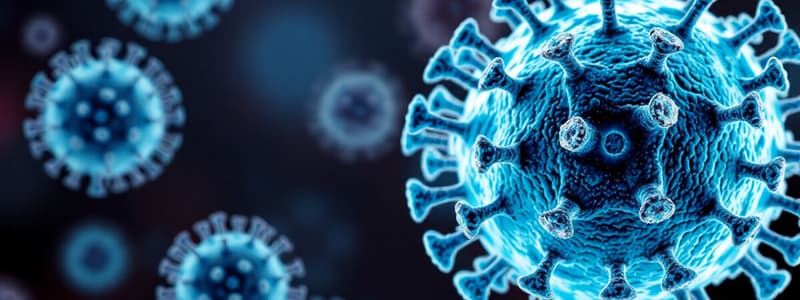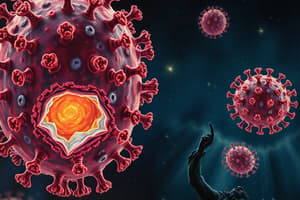Podcast
Questions and Answers
What is the sequence of events in the one-step growth curve of viruses?
What is the sequence of events in the one-step growth curve of viruses?
Binding to receptors, entering the cells, eclipse, assembly, and exit.
What does the eclipse time represent in viral replication?
What does the eclipse time represent in viral replication?
The time after the virus has penetrated the cell until the first progeny of virions become visible.
Which of the following is true regarding susceptible and permissive cells?
Which of the following is true regarding susceptible and permissive cells?
- Susceptible cells can complete the replication cycle.
- Permissive cells cannot be infected by a virus.
- Permissive cells can replicate the virus. (correct)
- Susceptible cells allow infection but not replication. (correct)
Name one method of viral penetration.
Name one method of viral penetration.
The viral _____ opens and frees the genome.
The viral _____ opens and frees the genome.
What is the role of RNA-dependent RNA polymerase in single-stranded negative sense RNA viruses?
What is the role of RNA-dependent RNA polymerase in single-stranded negative sense RNA viruses?
Which statement is true about the assembly step in viral replication?
Which statement is true about the assembly step in viral replication?
Naked viruses exit the host cell primarily by exocytosis.
Naked viruses exit the host cell primarily by exocytosis.
Which enzyme is unique to retroviruses?
Which enzyme is unique to retroviruses?
Match the following viral characteristics with their respective points:
Match the following viral characteristics with their respective points:
Flashcards are hidden until you start studying
Study Notes
Viral Replication Overview
- Viral replication involves attachment, penetration, uncoating, transcription, translation, replication, assembly, and release.
- Growth curves track the increase in infectious virus over time in culture.
One-Step Growth Experiment
- Sequence of events: binding to receptors, entry into cells, eclipse (genome replication and protein production), assembly, and release.
- Eclipse period: 2-12 hours, varies by virus family/genus; critical for antiviral intervention.
Cell Types
- Susceptible cell lines: can be infected but don’t complete the replication cycle.
- Permissive cell lines: allow full virus replication.
Studying Unculturable Viruses
- Constructing infectious clones involves inserting viral genomes into plasmids to bypass receptor requirements for infection.
Basic Steps in Viral Replication
- Attachment: Viral receptors connect with host cell receptors.
- Penetration: Viral entry occurs via membrane fusion or endocytosis. Naked viruses often enter through endocytosis.
- Uncoating: Viral capsid disassembles to free the genome, assisted by cellular chaperones when necessary.
Transcription and Translation
- Transcription converts the viral genome into mRNA. DNA viruses typically use host RNA polymerase in the nucleus; some cytoplasmic viruses have their own.
- Single-stranded (+) RNA viruses can translate directly, while (-) RNA viruses require their own polymerase to transcribe mRNA.
Post-Translational Modifications
- Viral mRNAs often acquire a 5' cap and a poly(A) tail for stability and transport, protecting them from degradation.
- Methylation and splicing may occur; viral mRNAs can carry information for multiple proteins (polycistronic).
Assembly and Release
- Structural proteins form capsids that encapsulate viral genomes; assembly may require cleavage of viral proteins.
- Naked viruses typically exit by cell lysis, while enveloped viruses bud from cellular membranes, incorporating membrane proteins.
Retrovirus Replication
- Retroviruses (e.g., HIV) use reverse transcriptase to convert RNA into DNA, integrating into the host genome.
- They possess long terminal repeats (LTRs) that facilitate integration and act as strong promoters for transcription of viral RNA.
- Retroviral cycles include RNA genome copying, generation of both mRNA and full-length genomic RNA for progeny.
Key Concepts
- Viral replication cycles are not uniform; they vary based on the virus type and host cell environment.
- Understanding viral replication aids in developing targeted antiviral therapies.
Studying That Suits You
Use AI to generate personalized quizzes and flashcards to suit your learning preferences.




